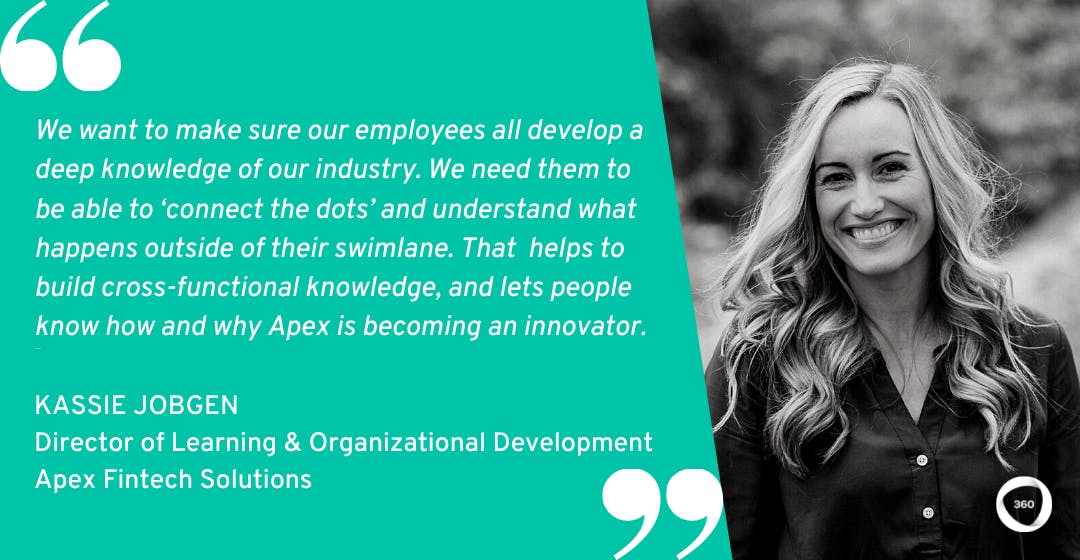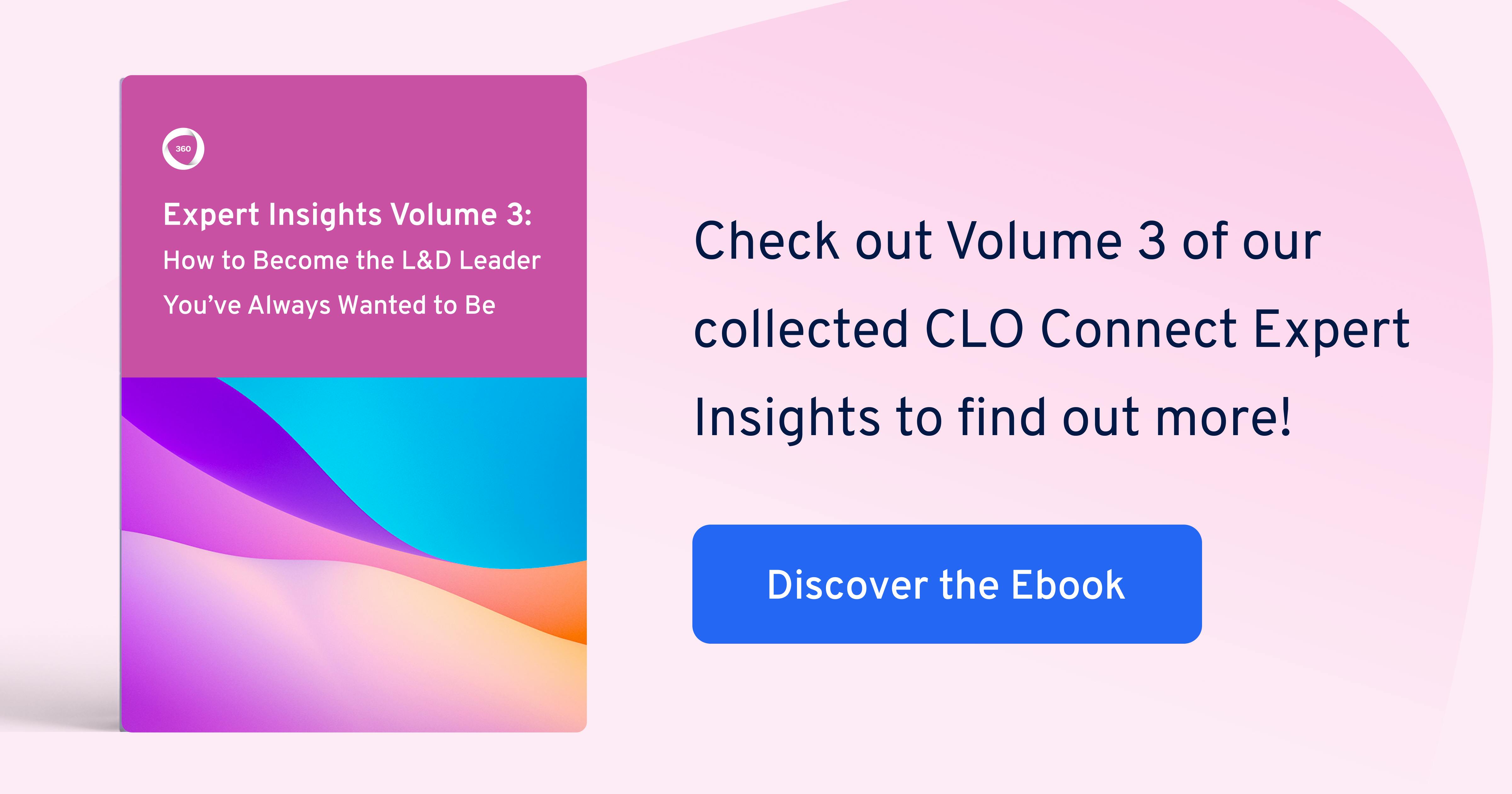Every L&D leader knows the best learning content doesn’t just offer new information and practical skill development–it does this by telling a great story.
But how can L&D teams create these stories? And how can subject-matter experts be encouraged to channel their knowledge into compelling learning content to benefit others?
I’m always looking for great examples of L&D leaders telling stories with their learning content. That’s why it was such a pleasure to chat with Kass Jobgen, Director of Learning & Organizational Development at Apex Fintech Solutions, about her three-step playbook for helping learners connect the dots with consistently engaging learning stories.
Kass had a lot of practical tips to share–read on to find out more.
Loving what you’re reading? Come and join the L&D Collective for more great learning insights, resources, and events!
Why it’s so important to connect the dots in times of growth
Kass started our conversation by telling me all about Apex’s incredible growth journey–and what that means for L&D.
“Apex Fintech Solutions, or AFS, is really in an exciting growth phase,” she says. “We’re going through a lot of change and transformation right now, and we’ve acquired a couple of different companies. We’re really focusing on ensuring our new and existing employees feel supported and continue to have the right opportunities for growth and development in this exciting time.”
“With Apex growing so much, our executives recognized the importance of having a standalone L&D department come in and support everyone throughout this change and transformation.”

So, what was Kass hoping to achieve with this L&D support? As she explains, the most important thing was to build cross-functional knowledge to help support company growth.
“We really want to make sure our new and existing employees all develop a deep knowledge of our industry and business. We need them to be able to ‘connect the dots’ and understand what happens outside of their swimlane. That really helps to build cross-functional knowledge, and lets people know how and why Apex is becoming an innovator in the industry.”
But how exactly is Kass creating these learning opportunities? She broke it all down with her three-step playbook.
Need a few more CLO Connect expert insights? Find out How to Become the L&D Leader You’ve Always Wanted to Be.
Apex’s 3-step playbook for creating story-driven learning content
As Kass explained, she knew she and the L&D team needed to support Apex’s growth with a collaborative learning approach.
“We wanted to create an Apex education program,” says Kass. “We used a collaborative microlearning approach delivered through a learning management system. We incorporated all four learning styles within this program, and worked with 16 different subject-matter experts across the organization.”
For Kass, it was crucial to avoid one particular outcome: overburdening these subject-matter experts.
1. Use templates to make life easier for your subject-matter experts
“One thing I wanted to be really aware of was the bandwidth of the 16 subject-matter experts. They have their everyday jobs they need to stay on top of as well, and it’s really important not to overburden them.”
“That’s why we created a standard subject-matter expert template for them to go in, provide their answers, record an FAQ video, and gather feedback on the content. Then we as the L&D team would publish it. It was a very systematic process.”
I wanted to be really aware of was the bandwidth of the 16 subject-matter experts. They have their everyday jobs they need to stay on top of as well.
2. Give your lessons the same flow and feel with great storytelling
Next up, Kass was careful to ensure each lesson had the same flow and feel. Her secret weapon? Great storytelling.
“I wanted to ensure each lesson had the same flow and feel regardless of the complexity of the topic. We did this by ensuring our learning content told a clear and compelling story, and was as interactive as possible.”
“This can be as simple as including an FAQ video on the top three questions an expert might get on a particular topic, department, or product.”
I wanted to ensure each lesson had the same flow and feel regardless of the complexity of the topic. We did this by ensuring our learning content told a clear and compelling story.
3. Help your learners focus on the practical application of new skills
Finally, Kass also focused on keeping learning content practical.
“We also wanted to keep the focus on the practical application of new skills and information. Not only are learners hearing this information, but they’re also being asked to apply it to make sure that it sticks. We then reiterate this at the end of the lesson with a final quiz on the subject.”
As she explains, this project was a daunting one–but she and her team weren’t phased. “Overall we had about 27 lessons to create from scratch in roughly five months, with an L&D team of three people. It was pretty intense, but it was great–we had a lot of fun doing it.”
Apex’s three-step approach demonstrates many of the advantages of Collaborative Learning in practice: creating content at pace, using collective expertise to solve tough problems, and ensuring a consistently high quality of expert-driven learning content.
Related: Experts Engagement Tool: Leverage Subject-Matter Expertise With Collaborative Learning
We also wanted to keep the focus on the practical application of new skills and information. Not only are learners hearing this information, but they’re also being asked to apply it to make sure that it sticks.
Measuring the success of Apex’s story-driven learning strategy
That’s an overview of Apex’s three-step learning strategy. But how does Kass know whether this strategy is having the right impact?
“Just like with all our learning programs, we want to see the ROI in it, not only from our time, but from the organization’s time as a collective,” says Kass. “To assess this, we used pre-learning and post-learning tests with every lesson.”
“Once everyone had completed the curriculum, we pooled all of our data and found a 30% increase of knowledge across the organization as a result. This was fantastic, and it was really what I wanted to see.”
As she reiterates, the most important goal with this story-driven learning content is to help learners support Apex’s growth by building their cross-functional awareness.
“We wanted to encourage people to start thinking outside their swimlanes, because when everyone gets busy and there’s a lot of change and growth happening, it’s really easy to get tunnel vision. That’s why I was so happy to see how we were building an increased awareness of cross-functional knowledge within our organization.”
Related: 3 Data-Based Ways to Prove Training ROI (+ Free Training ROI Calculator)
We pooled all of our data and found a 30% increase of knowledge across the organization as a result. This was fantastic, and it was really what I wanted to see.
Thanks again to Kass for so generously sharing her knowledge and insights with us!
If you’re looking for more expert insights on leveraging subject-matter expertise, check out our interviews with Gaurav Maheshwari of Visa on how to decentralize course creation, and with Lachlan Fletcher of Instacart on how to support leaders with expert discussion circles.
Want more peer insights on transforming workplace learning? Sign up to become a member of the L&D Collective, and check out our other #CLOConnect interviews with top L&D leaders on driving growth and scaling culture through Collaborative Learning. Or you can subscribe (below 👇) to our weekly newsletter to receive our latest posts directly in your inbox.



